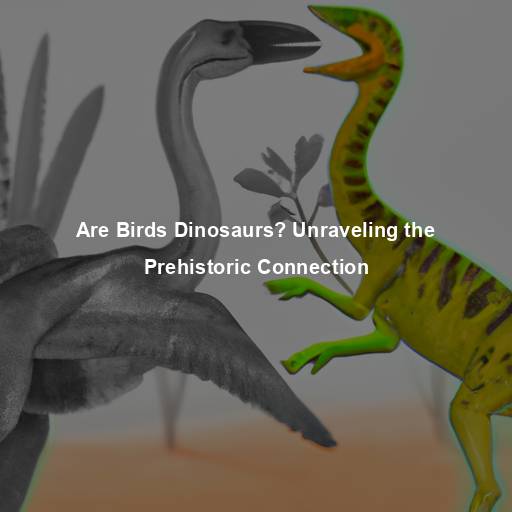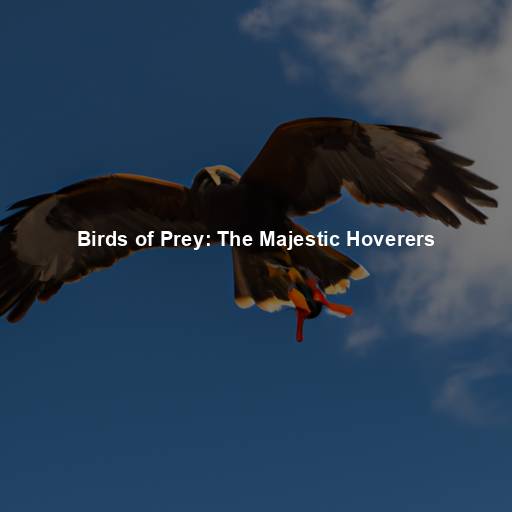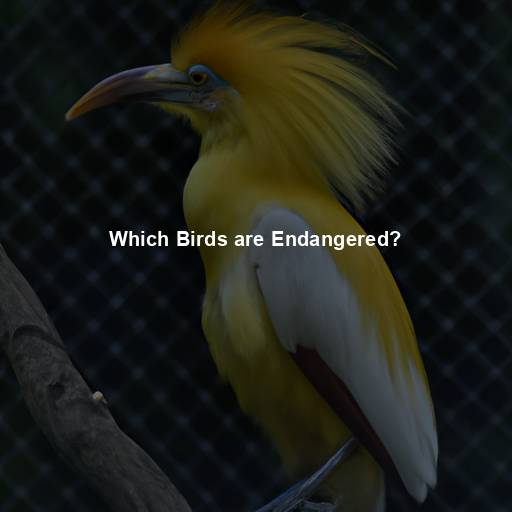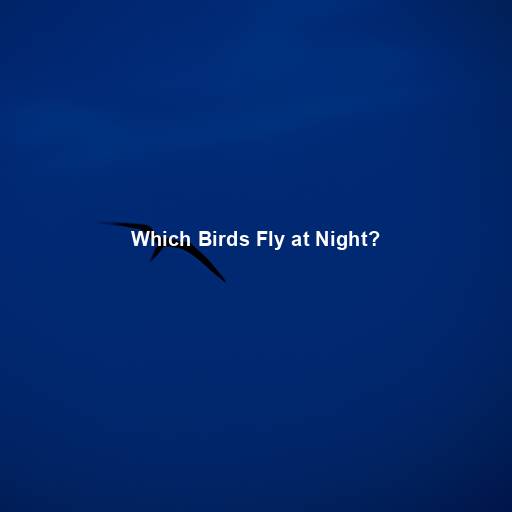Are Birds Dinosaurs? Unraveling the Prehistoric Connection
Last Updated on November 17, 2023 by Evan
Contents
- 1 Unveiling the Ancient Origins
- 1.1 The Astonishing Linkage
- 1.2 A Glimpse into the Prehistoric Past
- 1.3 The Clues in the Genes
- 1.4 A World of Feathers
- 1.5 A Paradigm Shift in Understanding
- 1.6 Mastery of Flight
- 1.7 Beaks and Bills: A Diverse Array of Tools
- 1.8 Colorful Plumage: Nature’s Palette
- 1.9 Nesting and Parental Care
- 1.10 The Future of Avian Dinosaurs
- 1.11 Ecosystem Engineers
- 1.12 Avian Dinosaurs as Indicator Species
- 1.13 The Conservation Imperative
- 1.14 The Enduring Legacy of Avian Dinosaurs
- 2 FAQs: Are the Birds Dinosaurs
- 2.1 What is the relationship between birds and dinosaurs?
- 2.2 How do we know that birds are dinosaurs?
- 2.3 Are all birds classified as dinosaurs?
- 2.4 Do birds have any characteristics that resemble dinosaurs?
- 2.5 Can we consider birds to be living dinosaurs?
- 2.6 Are there any dinosaur species that are not related to birds?
Unveiling the Ancient Origins
The world of dinosaurs has always captured our imagination, with their gigantic frames and tumultuous reign over the Earth. But did you know that birds, those graceful creatures that take to the sky with elegance and finesse, are believed to be the direct descendants of dinosaurs? Yes, you heard it right! In this captivating exploration, we will delve into the fascinating scientific evidence that suggests birds are indeed modern-day dinosaurs, bridging the gap between the ancient past and the present.
The Astonishing Linkage
- Avian Evolution: To unravel the connection between birds and dinosaurs, we must first understand the concept of evolution. Over millions of years, organisms undergo gradual changes to adapt to their environment, leading to the emergence of new species. This evolutionary process is no different for birds.
Unraveling the fascinating mysteries of the past, recent paleontological discoveries have left scientists and enthusiasts alike in awe. It turns out that our feathered friends, the birds, have a much stranger and more profound lineage than we could have ever imagined. Can you believe it? Research now suggests that these graceful creatures share a direct ancestral connection with a prominent group of dinosaurs known as theropods, those fierce, bipedal, flesh-eating giants that once prowled the ancient Earth.
A Glimpse into the Prehistoric Past
Unlocking the secrets of the ancient world, fossils offer us an enthralling glimpse into a bygone era, where majestic beings roamed the Earth. In a dazzling display of scientific discovery, paleontologists have unearthed a breathtaking array of fossils that unravel the intricate relationship between avian creatures and their prehistoric counterparts. Awe-inspiring and mystifying, these fossilized wonders reveal astonishing resemblances in the skeletal framework, connecting the dots between graceful modern birds and the awe-inspiring dinosaurs of eons past.
Intriguing Connections: A fascinating discovery unfolds as we delve into the realm of avian lineage. Through a meticulous analysis, the striking resemblance of skeletal attributes between present-day birds and their prehistoric relatives emerges. Unveiling a tapestry of shared characteristics, we encounter a world where hollow bones, wishbones, and echoes of reptilian scales intertwine in an unforeseen harmony. A journey through time and anatomy reveals the profound perplexity and interconnectedness of these diverse creatures.
The Clues in the Genes
Uncovering the enigma of birds’ lineage, modern scientists have journeyed beyond the realm of fossils and delved into the mesmerizing realm of genetic analysis. Through a captivating exploration of DNA, these fearless researchers have unearthed astonishing parallels, illuminating the intricate evolutionary relationship between birds and their mighty ancestors, the dinosaurs. As genetic patterns intertwine, the captivating narrative of avian descendants takes shape, leaving us spellbound by the profound interconnectedness of the natural world.
- Shared Genetic Sequences: Through meticulous study, scientists have identified shared genetic sequences between birds and dinosaurs. These sequences provide compelling evidence of a common ancestry and further support the hypothesis that birds are, in fact, the last remaining dinosaurs.
A World of Feathers
Feathers: A Mesmerizing Link: The allure of feathers transcends time and species, weaving together the tales of birds and dinosaurs in an enigmatic dance. It’s easy to associate feathers with their graceful avian counterparts, yet our understanding takes flight as we unravel the astonishing fabric of history. Recent discoveries have unveiled the hidden truth that feathers, like hidden gems, adorned the bodies of theropod dinosaurs. As we embark on this perplexing journey, a vivid tapestry of extraordinary creatures emerges, fueling our imagination and deepening the bond between birds and dinosaurs.
- The Evolution of Flight: The development of feathers in theropod dinosaurs opened the door to the evolution of flight. Over time, these feathers underwent modifications, leading to the extraordinary flying abilities we observe in birds today. From soaring eagles to agile hummingbirds, the diverse range of avian flight showcases the remarkable evolutionary journey from dinosaurs to birds.
A Paradigm Shift in Understanding
Take a moment to dive into the captivating world of paleontological discoveries, where the boundaries of knowledge are constantly being pushed. Our perception of dinosaurs, once thought to be hulking reptiles, has taken a remarkable turn. The mind-boggling revelation that birds are the living descendants of these prehistoric giants has ignited controversy and intrigue, reshaping our understanding of these majestic creatures. Brace yourself for a thrilling encounter with a new perspective that promises to astound and perplex even the most seasoned dinosaur enthusiasts.
- Living Dinosaurs Among Us: By recognizing birds as living dinosaurs, we gain a newfound appreciation for their remarkable adaptability. These majestic creatures have not only withstood the test of time but have thrived and diversified, occupying nearly every corner of our planet.
Mastery of Flight
Birds have long fascinated us with their awe-inspiring ability to soar through the air, a skill that sets them apart from other creatures. Over countless millennia, these avian dinosaurs underwent incredible transformations, evolving a multitude of adaptations that enabled them to navigate the boundless skies with astonishing efficacy. Their journey from prehistoric ancestors to wings outstretched in the heavens is a testament to the marvels of evolution and the wonders of the natural world.
Feathers, the exquisite marvels of nature, have forever changed the course of life in the skies. Through an intricate evolution, these delicate structures have become the embodiment of flight itself, enabling creatures to defy gravity with their mesmerizing grace and agility. Their secret lies within their design – a symphony of interlocking barbs that form a central shaft, bestowing aviators with the power to soar and glide through the heavens. Let us embark on a journey through time, unearthing the enigmatic origins and unparalleled adaptability of these feathered wings that have forever captivated our collective imagination.
– Hollow Bones: Another crucial adaptation for flight is the presence of hollow bones. By reducing weight without compromising structural integrity, birds are able to achieve a high degree of agility in the air.
– Winged Innovations: Birds have also evolved various wing shapes and sizes to suit their specific flight requirements. From the broad wings of soaring raptors to the sleek, elongated wings of swifts and swallows, each adaptation enables birds to excel in their respective aerial pursuits.
Beaks and Bills: A Diverse Array of Tools
Birds exhibit an astounding diversity of beak shapes and sizes, each tailored to their specific feeding habits and ecological niches. These specialized beaks are a testament to the versatility and adaptability of avian dinosaurs.
- Carnivorous Beaks: Raptors such as eagles and falcons possess sharp, hooked beaks ideal for tearing into flesh. These formidable predators showcase the predatory heritage of their dinosaurian ancestors.
- Seed Crackers and Insect Probers: Finches and sparrows, on the other hand, have evolved beaks that are well-suited for cracking open seeds or probing into crevices to extract insects. These beak adaptations reflect the diverse dietary preferences of birds.
Discover the mesmerizing world of filter feeders, where nature’s ingenuity takes flight. Witness the graceful elegance of flamingos, their beaks delicately curved to sift sustenance from the depths. Marvel at the spoonbills, whose uniquely shaped bills unlock a special talent for extracting nourishment from water and mud. Behold these extraordinary adaptations that showcase the boundless variety within the avian realm, leaving us in awe of the perplexing wonders of evolution.
Colorful Plumage: Nature’s Palette
Feathers, oh those enchanting plumes! They effortlessly swathe birds with vibrant shades that captivate the eyes, but their purpose surpasses mere visual delight. These mesmerizing displays whisper tales of the rich evolutionary history of avian dinosaurs, leaving us awe-struck and perplexed by the wonders of nature’s creativity.
The dazzling world of bird plumage never ceases to amaze us with its remarkable adaptations. Take, for instance, the mesmerizing art of camouflage. Countless avian species have mastered the skill of blending effortlessly into their surroundings, rendering them virtually invisible to the watchful eyes of predators and unsuspecting prey alike. Through the intricate patterns and color schemes of their feathers, these birds have unlocked nature’s secret recipe for survival, leaving us in awe of their unparalleled ingenuity.
– Courtship Rituals: For some species, elaborate plumage plays a central role in courtship displays. Males of certain bird species showcase vibrant colors and intricate patterns to attract mates and establish dominance within their communities.
When it comes to birds, recognizing their own kind can sometimes be a real challenge. Why, you may ask? Well, it turns out that their plumage patterns and colors play a vital role in this intricate affair. By flaunting unique markings, these feathered beings can successfully distinguish between their fellow species and those who could be vying for the same spotlight.
Nesting and Parental Care
The nurturing and care of offspring are fundamental aspects of avian dinosaur behavior. Birds exhibit a remarkable range of nesting strategies and parental care methods that showcase the deep-rooted instincts passed down from their dinosaurian ancestors.
- Nest Diversity: Birds construct an astonishing array of nests, from simple depressions in the ground to elaborate structures woven from twigs, leaves, and even mud. Each species tailors their nest-building techniques to suit their specific ecological requirements.
In the intricate world of avian reproduction, the captivating stage of incubation holds a vital key to life’s continuity. Birds, with their ingenious ways, deploy a myriad of tactics to safeguard the growth and prosperity of their precious eggs. Astonishingly, some avian species gracefully take turns in the sacred act of incubation, allowing each partner to bask in the profound joy of nurturing life. Meanwhile, other astonishing feathered wonders find solace in the comforting embrace of volcanic vents or the natural warmth bestowed upon them by sandy beaches, effortlessly weaving their existence into the marvel of nature’s symphony. - Feeding and Protection: Once the eggs hatch, avian dinosaurs display remarkable dedication to feeding and protecting their young. From regurgitating food for nestlings to fiercely defending their nest from predators, birds exemplify the profound parental care ingrained in their dinosaurian lineage.
The Future of Avian Dinosaurs
As we delve further into the enigmatic world of avian dinosaurs, we are haphazardly unlocking the intricacies of life’s intricate tapestry on our humble planet. The awe-inspiring birds, with their primordial lineage and astonishing evolutionary adjustments, stand as an indubitable testament to the timeless imprint of the colossal dinosaurs that once graced this terrestrial realm.
By studying avian dinosaurs, scientists not only gain insights into the past but also valuable knowledge that can inform conservation efforts and environmental stewardship. As we strive to protect and preserve these captivating creatures, we honor the ancient bond between dinosaurs and birds, ensuring that their lineage continues to inspire and captivate us for generations to come.
When we take a moment to appreciate the graceful flight and enchanting melodies of birds, we are reminded of their incredible heritage as living dinosaurs. These magnificent creatures are a testament to the remarkable process of evolution, showcasing the enduring spirit of life on our planet. Their ecological impact cannot be underestimated, as they play crucial roles in maintaining the delicate balance of ecosystems worldwide. Let us marvel at the burst of perplexity that comes with realizing that amidst our everyday lives, we are privileged to witness the living legacy of the prehistoric world.
Ecosystem Engineers
Avian dinosaurs, through their interactions with the environment, play a vital role in shaping and maintaining ecosystems. Their behaviors and ecological functions have far-reaching impacts on the balance and health of the natural world.
Seed Dispersal and Plant Pollination
- Seed Dispersers: Many bird species act as seed dispersers, aiding in the propagation and distribution of plants. As birds consume fruits and berries, they inadvertently transport seeds to new locations, allowing plants to colonize different areas and ensuring genetic diversity.
- Pollinators: In addition to seed dispersal, birds also contribute to plant reproduction through pollination. As they feed on nectar, pollen sticks to their feathers and beaks, facilitating cross-pollination between flowers and ensuring the survival of plant species.
Pest Control and Insect Regulation
When it comes to delightful avian creatures, there is a captivating group that is often overlooked: insectivorous birds. These feathered hunters have undergone remarkable adaptations to fulfill their insatiable appetite for insects, becoming skilled insect connoisseurs. With their voracious appetites, they take on the vital task of keeping insect populations in check and maintain the delicate equilibrium of our precious ecosystems. So, let’s dive into the mesmerizing world of these bug-loving birds and explore the fascinating role they play in nature’s grand tapestry.
Nutrient Cycling and Decomposition
- Scavengers and Decomposers: Certain bird species, such as vultures and crows, have adapted to feed on carrion and decaying organic matter. By consuming and breaking down carcasses, they contribute to nutrient cycling and decomposition, ensuring the efficient recycling of organic material within ecosystems.
Avian Dinosaurs as Indicator Species
The wonder that birds bring is not limited to their graceful flight and melodious songs. These incredible creatures, in all their vibrant avian glory, hold the keys to understanding the delicate balance of our ecosystems. By closely observing their populations and intricate behaviors, we embark on an exploration of Mother Nature’s pulse, seeking clues to decipher the impact of our own human footprints on these intricate ecosystems.
Habitat Loss and Fragmentation
The rapid deforestation and destruction of habitats have created a perplexing situation for our feathery friends. With trees being mercilessly felled and their natural homes disrupted, bird species find themselves in a burst of confusion as they search for suitable nesting sites to raise their young, reminiscent of their prehistoric ancestors, the avian dinosaurs. The loss of these critical sanctuaries casts a shadow of uncertainty over the survival of these winged creatures.
Migration: A Perilous Journey: For the brave winged wonders that embark on long-distance migrations, the path ahead is riddled with perplexing challenges. The intricate issue lies in the fragmented habitats, which pose a grave threat to these tireless travelers. The vanishing stopover sites, the crucial resting and refueling havens for these feathered adventurers, cast a shadow over their ability to accomplish their arduous migratory routes unscathed.
Pollution and Climate Change
- Toxic Impacts: Birds, particularly those residing in aquatic environments, are highly susceptible to the impacts of pollution. Contamination of waterways and food sources can lead to reduced reproductive success, impaired immune systems, and population decline.
- Shifts in Distribution: Climate change is causing shifts in bird distribution patterns as they adapt to changing temperature and precipitation patterns. Some species are moving to higher latitudes or elevations in search of suitable habitats, while others are struggling to adapt to new conditions.
The Conservation Imperative
Recognizing the vital ecological role played by avian dinosaurs, conservation efforts are essential to ensure their continued survival and the preservation of the ecosystems they inhabit.
Habitat Conservation and Restoration
Discover the incredible world of protected areas, a vital refuge for the awe-inspiring avian dinosaurs. As we witness the expansion of these sanctuaries, such as national parks and wildlife reserves, their significance in providing safe havens for our feathered friends becomes ever more paramount. These protected spaces not only enable birds to freely engage in crucial activities like breeding, foraging, and migrating, but also ensure the preservation of their populations and the delicate balance of their ecosystems. Brace yourself for a journey filled with awe, as we uncover the remarkable role of protected areas in safeguarding our avian companions and the natural world they inhabit.
In a world where human activities have left many habitats in a state of disarray, the pressing need for habitat restoration has become increasingly apparent. From ambitious reforestation projects that breathe life back into once barren landscapes to the creation of wildlife corridors that mend the fragmented tapestry of nature, these endeavors hold the key to providing a lifeline for countless species. By reinstating suitable nesting sites and reestablishing vital connections between habitats, we embark on a journey towards a more interconnected and resilient ecosystem.
Sustainable Practices and Awareness
- Responsible Land Use: Promoting sustainable land-use practices, such as responsible forestry and agriculture, helps mitigate habitat loss and degradation. By minimizing the impact of human activities on avian habitats, we can protect these vital ecosystems.
- Public Education: Raising awareness about the importance of birds as indicators of environmental health can inspire collective action. Educating communities about the ecological role of avian dinosaurs fosters appreciation and support for conservation efforts.
The Enduring Legacy of Avian Dinosaurs
Bird-like dinosaurs have an uncanny ability to mesmerize us, not just with their ethereal charm but also with their crucial contribution in preserving our planet’s intricate web of life. With a deep understanding of their ecological value, it becomes imperative for us to champion their cause, shielding their habitats from harm. Embracing this responsibility ensures the perpetual existence of these extraordinary beings, while nurturing the wellbeing and diversity of our precious environment.
As we gaze in wonder at the graceful dance of birds soaring through the sky and find solace in their captivating melodies, we are prompted to reflect upon the enigmatic ties that link us to the mysteries of our ancestral past. The avian dinosaurs that once roamed the Earth embody not only the incredible saga of evolution, but also serve as a poignant reminder of our collective duty to safeguard and nurture the precious marvels of our fragile planet, ensuring their survival for the generations yet to come.
FAQs: Are the Birds Dinosaurs
What is the relationship between birds and dinosaurs?
It’s truly mind-boggling to think that birds, those graceful creatures that flit through our skies, are actually direct descendants of dinosaurs. Yes, you heard that right – dinosaurs! Specifically, avian dinosaurs known as theropods. Picture it: the Mesozoic Era, a whopping 150 million years ago, when our feathered friends first emerged from the depths of prehistoric times. They share an incredible ancestry with some of the most fearsome dinosaurs to ever roam the Earth, like the mighty Tyrannosaurus rex and the cunning Velociraptor. Can you believe it? Birds are the last remaining survivors of the dinosaur lineage, carrying with them a legacy that’s bound to make anyone’s jaw drop.
How do we know that birds are dinosaurs?
It’s simply mind-boggling how much evidence has been unearthed to support the mind-blowing theory that birds are actually descendants of dinosaurs. I mean, seriously, have you seen those fossils? They are like pieces of a prehistoric puzzle that connect the dots between these feathered creatures and their ancient reptilian ancestors. And if that’s not enough to make your head spin, genetic studies have also chimed in to confirm the mind-bending relationship between birds and dinosaurs. Who would have thought that these seemingly distinct creatures are actually part of the same perplexing family tree?
Are all birds classified as dinosaurs?
Yes, all birds are classified as dinosaurs. The classification system used by scientists categorizes birds within the broader group of reptiles, which also includes dinosaurs. From a taxonomic standpoint, birds belong to the dinosaur group called theropods, which includes the carnivorous dinosaurs known for their bipedal stance, sharp claws, and hollow bones.
Do birds have any characteristics that resemble dinosaurs?
Birds, fascinating creatures with their stunning diversity, continue to call into question the evolutionary connections between reptiles and dinosaurs. Bursting with perplexing similarities, these feathered friends astonish with their long tails, reminiscent of their prehistoric counterparts, although now refined for the art of flight. And let’s not forget their majestic legs, strong and clawed, like a relic from the age of theropod dinosaurs, visible today in the wondrous forms of cassowaries and ostriches. Oh, and have you ever noticed the subtle scales on their legs, a nod to their reptilian lineage? Nature’s curiosities truly know no bounds.
Can we consider birds to be living dinosaurs?
Yes, birds are often referred to as living dinosaurs because they are the only group of dinosaurs that survived the extinction event that occurred approximately 66 million years ago. Unlike their dinosaur relatives, birds diversified and adapted to various ecological niches over millions of years, leading to the incredible diversity of avian species we observe today.
Birds may be the sole torchbearers of the dinosaur legacy, but let’s not overlook the Marvels that existed outside this avian dynastic realm. For an awe-inspiring span of 160 million years, dinosaurs thrived in diverse forms, giving rise to extraordinary species such as the formidable Triceratops and the towering Brachiosaurus, both of which boast a dietary preference for vegetation. While these dinosaur clans aren’t the direct catalysts of avian evolution, they are entwined in the epic tapestry of reptilian ancestry, sharing a profound evolutionary voyage that defies simple classification. Our understanding of these ancient marvels deepens as we continue to unravel the perplexities of the past.







